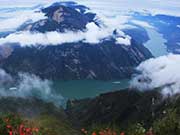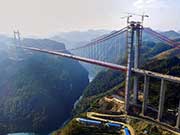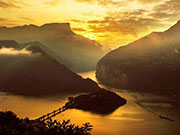

Dai Jianfeng, 27, has spent four years shooting beautiful, starry skies in many regions of China such as Tibet, Yunnan and Sichuan. One of his works from 2014, which shows a spiral of stars in the sky, was adopted by NASA and published in the Proceedings of the National Academy of Sciences in the United States.
More and more people have the opportunity to see these beautiful views thanks to Dai and his camera. In fact, before he fell in love with shooting them, he barely ever even saw stars because he grew up in southwest China's Chongqing city, which is famous for its fog.
Dai still remembers his first time enjoying the shimmering stars above Mount Fanjing in Tongren city, southwest China's Guizhou province. He started to collect photos of starlit skies and taught himself some astronomy after he returned to Chongqing. "I was shocked by how breathtaking these photos were, and I made up my mind to shoot the beautiful starry sky myself so I could share it with the public," said Dai.
From then on, together with other astrophiles, Dai learned photography techniques and went outdoors to take photos of the sky every weekend and holiday.
After being invited by the Chinese Astronomy Society, Dai participated in the documentary production of the 28th International Astronomy Union in 2012. His works have been published in many magazines such as National Geographic, Astronomy, Sky and Telescope and others.
Three photos by Dai Jianfeng were shortlisted for Astronomy Photograph of the Year, which was held by the Royal Greenwich Observatory in May 2015. Some of the works were published in an album, which was displayed in the U.K.
After four years of being an enthusiastic novice, Dai got the idea to become a professional photographer. "I had seen many beautiful places and skies that no one had ever shot before. I gradually realized that it is my mission to shoot the starlit skies," said Dai.
Now, Dai has quit his job and travels full-time around China, Nepal, India, the Kingdom of Bhutan and Pakistan. "We saw the morning star rising over Nnamjagbarwa Mountain in Nyingchi Prefecture, southwest China's Tibet Autonomous Region. One hour later, people will see the same sight above the Nanga Parbat Peak in the Kashmir region of Pakistan. There is no boundary between nations in the vast scheme of the universe. We are all just small specks on the planet. I want to promote exchange and communication between countries through my work," said Dai when he was in Lhasa.
 |
Day|Week

 Spectacular aerial photos of the Three Gorges
Spectacular aerial photos of the Three Gorges Admit it! That is a High-way built by China
Admit it! That is a High-way built by China Photos of Beijing Film Academy student hit the Internet
Photos of Beijing Film Academy student hit the Internet Spectacular aerial photos of the Three Gorges
Spectacular aerial photos of the Three Gorges New balls please! Polish sports stars strip off for risqué calendar
New balls please! Polish sports stars strip off for risqué calendar A glance at life of Ukrainian models working in Chongqing
A glance at life of Ukrainian models working in Chongqing Contestants of Mrs. Globe pose for photo in Shenzhen
Contestants of Mrs. Globe pose for photo in Shenzhen
 Bikini models attend hot pot banquet in Hefei
Bikini models attend hot pot banquet in Hefei 118-meter-high Never-used Building in NW. China Demolished
118-meter-high Never-used Building in NW. China Demolished J-10B fighters with homegrown engine in test flight
J-10B fighters with homegrown engine in test flight